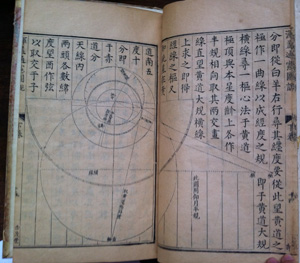 Recently, a very rare Chinese book was discovered at the Peabody Library. Hun Gai Tong Xian Tu Shuo (Illustrated Explanation of Cosmological Patterns) was published in 1607 and written by Zhizao Li (1565-1630), a prominent mathematician and astronomer in the Ming Dynasty (1368-1644).
Recently, a very rare Chinese book was discovered at the Peabody Library. Hun Gai Tong Xian Tu Shuo (Illustrated Explanation of Cosmological Patterns) was published in 1607 and written by Zhizao Li (1565-1630), a prominent mathematician and astronomer in the Ming Dynasty (1368-1644).
Li was a student of Matteo Ricci, the famed Italian Jesuit missionary to China. Ricci fascinated and attracted the Chinese intelligentsia with his Renaissance erudition. A group of elite Confucian scholars and court academics eventually became Ricci’s scientific apostles, converted to Catholicism, learned Western science from him and became the pioneers in modern science in China. Zhizao Li was one of them.
Based on Ricci’s teaching and his own practice, Li wrote Illustrated Explanation of Cosmological Patterns, introducing principles and methodology of the stereographic projection of the celestial sphere. This is the first Chinese work on Western astronomical instrument and geometry.
According to National Library of China’s rare books bibliography, the 1607 edition is the earliest edition. Currently, there are only six existing copies in China at different libraries. WorldCat indicates that the Peabody Library copy is the only 1607 edition outside China, a very rare copy indeed. Four hundred years after its publication, the book is still in fairly good condition, with string binding and beautiful zenographic printing and illustration.

This is indeed a remarkable find. You may know that there is also a rather widely circulated reprint published by the Taiwan Commercial Press in its congshu jicheng series.
Yuan, thanks for showing me the rare book. I was thrilled to see it when I was at the Peabody Library!
Wow, Yuan, you found an amazing thing!! Congratulations on spotting this extraordinary book!